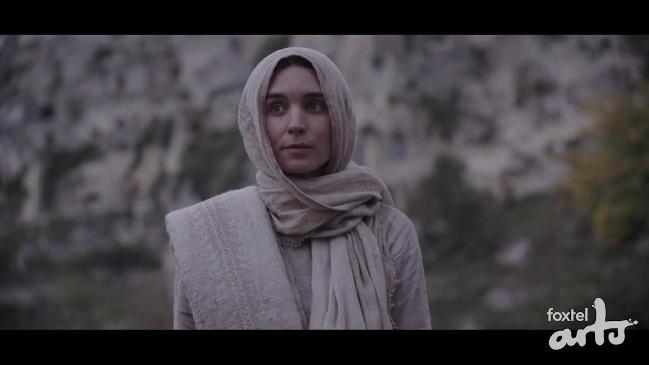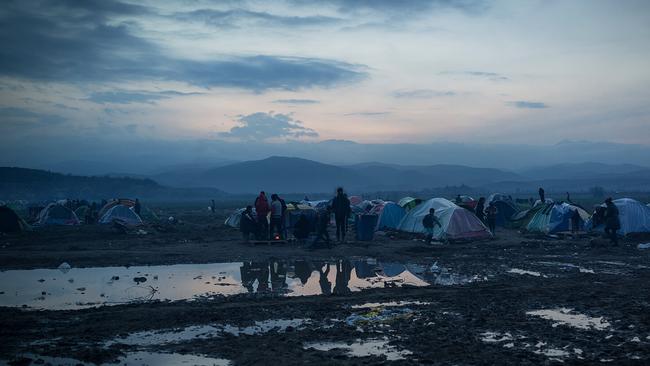Mary Magdalene, new depictions of ’13th apostle’ Judas; Human Flow
If you thought Mary Magdalene was a prostitute, you’d be wrong. A new film puts a feminist slant on her widely misunderstood life.

The story of Jesus Christ has been brought to the screen countless times since the cinema’s silent era. In 1927 it was considered rather shocking that Cecil B. DeMille, that canny old showman, had the audacity to cast an actor (HB Warner) as Jesus when the cautious practice until then had been not to depict Christ on screen. In later years actors as disparate as Jeffrey Hunter, Willem Dafoe, Max von Sydow, Jim Caviezel and — in Pasolini’s Marxist interpretation, The Gospel According to St Matthew (1964) — Enrique Irazoqui played Christ. For his follow-up to his internationally successful film debut, Lion, Australian director Garth Davis has cast Joaquin Phoenix in the role, and he’s pretty good.
This is a passive Christ, a gentle, thoughtful character with a kind word for everyone. But it’s not his story. Davis’s film, a British-Australian co-production, is titled Mary Magdalene and the gimmick, if you can call it that, is to tell the infinitely familiar story from the perspective of one of Christ’s most loyal followers.
If you thought Mary Magdalene was a reformed prostitute, you’d be wrong: according to the film’s end titles it was Pope Gregory who proclaimed this calumny in AD 591; the Mary Magdalene we see here, portrayed by the serenely beautiful Rooney Mara, is an “ordinary” young woman who lives with her family by the seashore, helps with the fishing and who acts as an unofficial midwife.
She encounters Jesus and the Apostles during a baptism ceremony and is immediately determined to follow him. The contention of the screenplay by Helen Edmundson and Philippa Goslett is that Mary became, in effect, the 13th apostle but, because she was a woman, she has been written out of history.
I have to say I found all this a bit hard to swallow. In the pages of the Bible it might seem plausible that Mary could tag along while Jesus and the Apostles spread the word as they travel the rocky countryside on their way to Jerusalem, but on screen the practicalities of the inclusion of a young and very beautiful woman in a group of men who have left their families behind opens up questions that might be blasphemous to answer. It doesn’t help that Mary comes across as an ardent groupie, or as an intern besotted by her boss.
Apart from Mary, the film’s most interesting character is not Jesus but Judas (Tahar Ramin), who is depicted as an extremely sympathetic and charming young man mourning the death of his wife and daughter but convinced that he’ll be reunited with them when the Kingdom of Heaven — the concept Jesus has promised will come — arrives. Judas believes this event will take the form of some kind of bloody revolution when Christ and the Apostles arrive in Jerusalem, and he’s so deeply disappointed that Christ misses a golden opportunity when he confronts the Scribes and Pharisees at the Temple that he “betrays” him, hoping thereby to move things forward in a positive direction.
Interestingly, in Nicholas Ray’s generally impressive King of Kings (1961), one of the most lavish Hollywood films on this subject, Judas and Barabbas are portrayed as members of a resistance movement of Jewish freedom fighters seeking the end of Roman rule, and the “betrayal” in that movie consists of a bungled political stratagem.
Despite the feminist slant that characterises Davis’s version of the story, it does seem rather a strange decision to revisit such familiar material. At least the film isn’t as gruelling and sadistic as Mel Gibson’s version, but it’s also less dramatic. Because we see the events entirely from Mary’s perspective, many of the key incidents are omitted — Mary manages to sleep throughout the period in which Jesus is brought before Herod and Pilate, so these characters don’t get a look in.
The film’s key sequence comes near the end when Peter (Chiwetel Ejiofor) has difficulty believing that the resurrected Christ would reveal himself to Mary and not to him. As for the other Apostles, they barely get a look in but simply function as a kind of Greek chorus.
There’s nothing wrong with any of the performances and the film looks magnificent. It was filmed on locations around Puglia in southern Italy as well as in Sicily, and the barren landscapes are superbly photographed by the exceptionally talented Australian cinematographer Greig Fraser. There’s also a stirring music score, the last composed by the late Johann Johansson, in collaboration with fellow Icelander Hildur Guanadottir.
There’s no doubt that Davis has taken some major risks with Mary Magdalene and while they don’t all pay off in completely satisfactory ways there are still enough qualities to make this intriguing piece of revisionism constantly watchable.

Human Flow undoubtedly has its heart in the right place. Chinese dissident and renowned artist Ai Weiwei filmed refugees in more than 20 countries with 25 film crews. There are North Africans on crowded boats landing on islands south of Greece and Italy. There are Rohingyas fleeing the brutality of the Myanmar regime. There are Mexicans trying to find a new life across the border in the US. There are closed borders in Europe — Macedonia, Hungary and Serbia. There are 75,000 refugees trapped near the Jordanian border and a vast refugee camp in Kenya. Australia and its refugee policy are not mentioned.
When the film received its world premiere in Venice, one critic unkindly, but rather accurately, described it as “basically Refugees for Dummies”. Ai is unquestionably sincere in wanting to bring the world’s attention to the refugee problem, but is this film the best way to do it? He overwhelms us with numbers and statistics, he presents us with some memorable imagery (Australia’s Christopher Doyle is one of the cinematographers) but, to be frank, we have seen most of this before, on television news bulletins and current affairs reports.
If Ai’s intention is to bring the world’s attention to an overwhelming problem, this film is surely preaching to the converted.
All that’s really new is Ai himself, and his presence is, frankly, pretty intrusive. He often appears in front of the camera, consoling a sickly woman, playing with a small child, having his head shaved by one of the refugees, asking obvious questions and receiving pretty elementary answers. A large number of UN and other humanitarian aid representatives offer their views, but Ai isn’t prepared to dig too deeply into the problem.
What he shows us is tragic and horrifying, but he offers no possible solutions and nothing much in the way of analysis.
Once or twice the two-hour 20-minute film achieves a kind of poetry — there’s a shot that looks, at first, like soldier ants crossing a fence but which, as the camera moves closer, proves to be a high overhead shot of refugees.
It’s a beautiful image, but arguably one that’s out of place in a film that is setting out, in its surprisingly clumsy way, to alert the world to one of the greatest tragedies in history.

Mary Magdalene (M)
3 stars
National release from Thursday
Human Flow (M)
2 stars
In release



